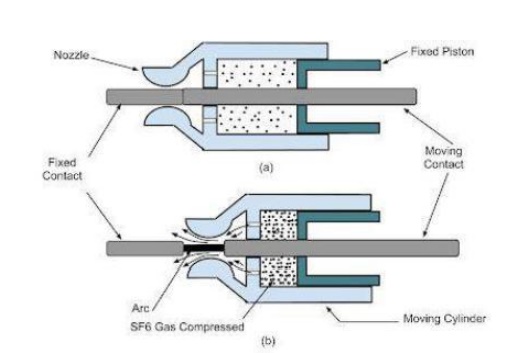SF6 circuit breaker
At this point we are aware that the medium in which arc extinction of the circuit breaker takes place greatly influences the important characteristics and life of the circuit breaker. the working of a vacuum circuit breaker was illustrated. We already know that the use of vacuum circuit breaker is mainly restricted to system voltage below 38 kV. The characteristics of vacuum as medium and cost of the vacuum CB does not makes it suitable for voltage exceeding 38 kV. In the past for higher transmission voltage Oil Circuit Breaker (OCB) and Air Blast Circuit Breaker (ABCB) were used. These days for higher transmission voltage levels SF6 Circuit Breakers are largely used. OCB and ABCB have almost become obsolete. In fact in many installations SF6 CB is used for lower voltages like 11 kV, 6 kV etc.. i)sulphur Hexafluoride symbolically written as SF6 is a gas which satisfy the requirements of an ideal arc interrupting medium. So SF6 is extensively used these days as an arc interrupting medium in circuit breakers ranging from 3 kv upto 765 kv class. In addition to this SF6 is used in many electrical equipments for insulation. Here first we discuss in brief, some of the essential properties of SF6 which is the reason of it's extensive use in circuit breakers
SF6 gas has high dielectric strength which is the most important quality of a material for use in electrical equipments and in particular for breaker it is one of the most desired properties. Moreover it has high Rate of Rise of dielectric strength after arc extinction.
This characteristics is very much sought for a circuit breaker to avoid restriking.
· SF6 is colour less, odour less and non toxic gas.
· SF6 is an inert gas. So in normal operating condition the metallic parts in contact with the gas are not corroded. This ensures the life of the breaker and reduces the need for maintenance.
· SF6 has high thermal conductivity which means the heat dissipation capacity is more. This implies greater current carrying capacity when surrounded by SF6 .
· The gas is quite stable. However it disintegrates to other fluorides of Sulphur in the presence of arc. but after the extinction of the arc the SF6 gas is reformed from the decomposition.
· SF6 being non-flammable so there is no risk of fire hazard and explosion.
A sulfur hexafluoride circuit breaker uses contacts surrounded by sulfur hexafluoride gas to quench the arc. They are most often used for transmission-level voltages and may be incorporated into compact gas-insulated switchgear. In cold climates, supplemental heating or de-rating of the circuit breakers may be required due to liquefaction of the SF6 gas.
Advantages:
· Due to superior arc quenching property of sf6 , such breakers have very short arcing time
· Dielectric strength of sf6 gas is 2 to 3 times that of air, such breakers can interrupt much larger currents.
· Gives noiseless operation due to its closed gas circuit
· Closed gas enclosure keeps the interior dry so that there is no moisture problem
· There is no risk of fire as sf6 is non-inflammable
· There are no carbon deposits
· Low maintenance cost, light foundation requirements and minimum auxiliary equipment
· sf6 breakers are totally enclosed and sealed from atmosphere, they are particularly suitable where explosion hazard exists

Disadvantages:
· sf6 breakers are costly due to high cost of sf6
· sf6 gas has to be reconditioned after every operation of the breaker, additional equipment is required for this purpose
CONSTRUCTION, PRINCIPLE OF OPERATION
The construction and working principles of SF6 circuit breaker varies from manufacturer to manufacturer. In the past double pressure type of SF6 breakers were used. Now these are obsolete. Another type of SF6 breaker design is the self blast type, which is usually used for medium transmission voltage. The Puffer type SF6 breakers of single pressure type are the most favored types prevalent in power industry. Here the working principle of Puffer type breaker is illustrated (Fig-A)
As illustrated in the figure the breaker has a cylinder and piston arrangement. Here the piston is fixed but the cylinder is movable. The cylinder is tied to the moving contact so that for opening the breaker the cylinder along with the moving contact moves away from the fixed contact (Fig-A(b)). But due to the presence of fixed piston the SF6 gas inside the cylinder is compressed. The compressed SFe gas flows through the nozzle and over the electric arc in axial direction. Due to heat convection and radiation the arc radius reduces gradually and the arc is finally extinguished at current zero.
The dielectric strength of the medium between the separated contacts increases rapidly and restored quickly as fresh SF6 gas fills the space. While arc quenching, small quantity of SF6 gas is broken down to some other fluorides of sulphur which mostly recombine to form SF6 again. A filter is also suitably placed in the interrupter to absorb the remaining decomposed byproduct.
The gas pressure inside the cylinder is maintained at around 5 kgf per sq. cm. At higher pressure the dielectric strength of the gas increases. But at higher pressure the SF6 gas liquify at higher temperature which is undesired. So heater is required to be arranged for automatic control of the temperature for circuit breakers where higher pressure is utilised. If the SF6 gas will liquify then it loses the ability to quench the arc. Like vacuum breaker, SF6 breakers are also available in modular design form so that two modules connected in series can be used for higher voltage levels. SF6 breakers are available as both live tank and dead tank types. In Fig-B above a live tank outdoor type 400 kV SF6 breaker is shown.

